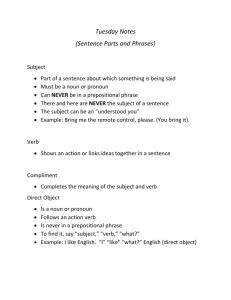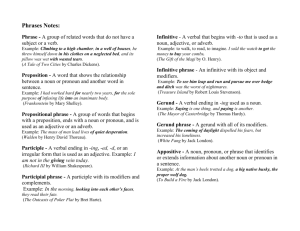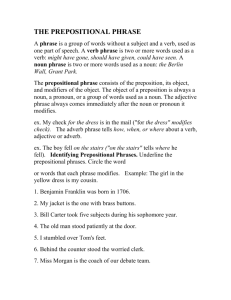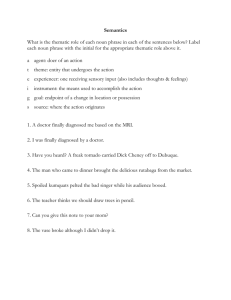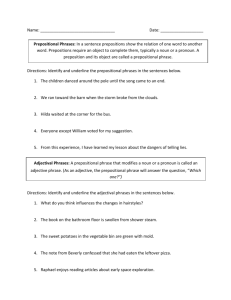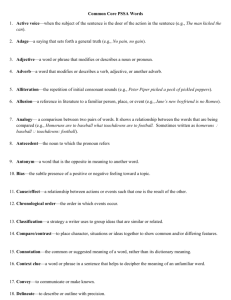M 326K, Sp 04 TOPIC 2: MATHEMATICAL LANGUAGE
advertisement
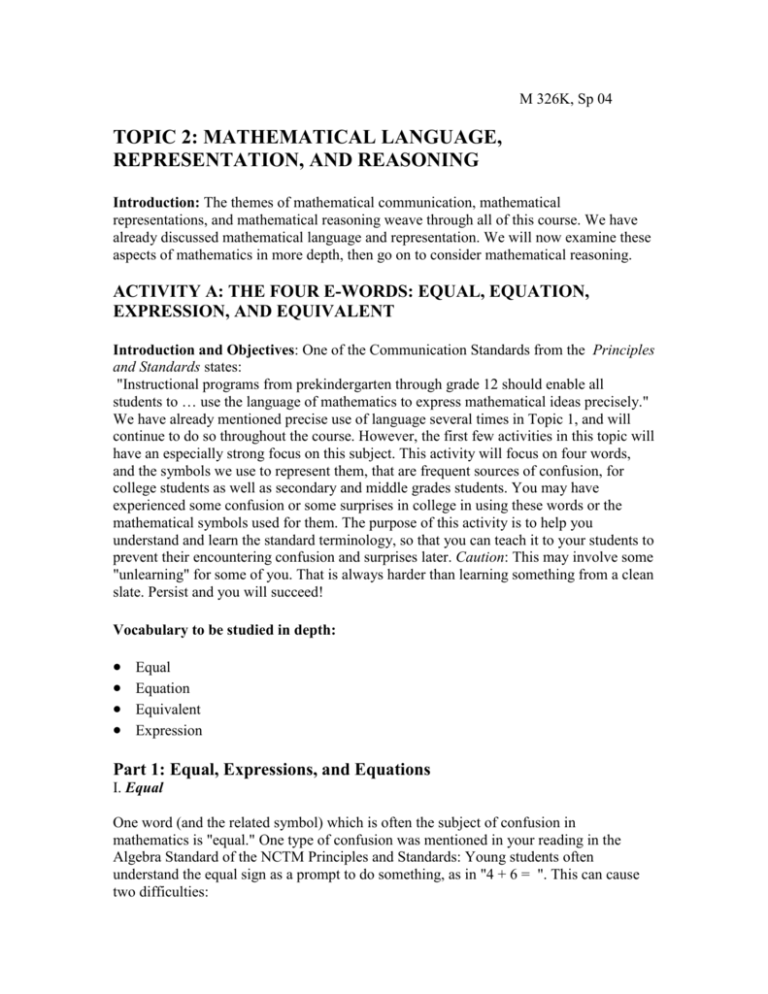
M 326K, Sp 04 TOPIC 2: MATHEMATICAL LANGUAGE, REPRESENTATION, AND REASONING Introduction: The themes of mathematical communication, mathematical representations, and mathematical reasoning weave through all of this course. We have already discussed mathematical language and representation. We will now examine these aspects of mathematics in more depth, then go on to consider mathematical reasoning. ACTIVITY A: THE FOUR E-WORDS: EQUAL, EQUATION, EXPRESSION, AND EQUIVALENT Introduction and Objectives: One of the Communication Standards from the Principles and Standards states: "Instructional programs from prekindergarten through grade 12 should enable all students to … use the language of mathematics to express mathematical ideas precisely." We have already mentioned precise use of language several times in Topic 1, and will continue to do so throughout the course. However, the first few activities in this topic will have an especially strong focus on this subject. This activity will focus on four words, and the symbols we use to represent them, that are frequent sources of confusion, for college students as well as secondary and middle grades students. You may have experienced some confusion or some surprises in college in using these words or the mathematical symbols used for them. The purpose of this activity is to help you understand and learn the standard terminology, so that you can teach it to your students to prevent their encountering confusion and surprises later. Caution: This may involve some "unlearning" for some of you. That is always harder than learning something from a clean slate. Persist and you will succeed! Vocabulary to be studied in depth: Equal Equation Equivalent Expression Part 1: Equal, Expressions, and Equations I. Equal One word (and the related symbol) which is often the subject of confusion in mathematics is "equal." One type of confusion was mentioned in your reading in the Algebra Standard of the NCTM Principles and Standards: Young students often understand the equal sign as a prompt to do something, as in "4 + 6 = ". This can cause two difficulties: (i) This prior misunderstanding of the equal sign may hinder understanding of the concept of equality, which is a fundamental idea of algebra. For example, a student who has attached this meaning to the equal sign may be stumped by a question such as "9 = 4 + ?," or confused by an equation such as "3 + 6 = 4 + 5" (ii)Even if students understand the concept of equality, they may also retain the "now we do something" meaning for the equal sign to write things like the following (as I am sure some of you have done!): (*) 4 + 5 = 9 - 7 = 2 or (**) 2x - 3 = 1 = 2x = 4 =x=2 Although this "abuse of the equal sign" is often convenient, it can be confusing, to the writer as well as to others. Literally, (*) asserts that "four plus five equals nine minus seven," which is of course not true. Similarly, (**) technically asserts that x is equal to both 4 and 2, which is a contradiction. (If you are used to writing things like (*) and (**), you may be asking now, "But how do I say what I want to say? We will get to this in Part 2 of this activity.) Adding to the confusion is the fact that the equal sign is translated into English in more than one way. For example, the sting of symbols 4+5=9=2+7 translates technically as "Four plus five equals nine, which equals two plus seven." In other words, the first "=" means "equals," and the second means "which equals." However, in practice we often read this informally as " Four plus five equals nine equals two plus seven." Exercises: 1. Why is it appropriate to say, "Four plus five equals nine" rather than, "Four plus five equal nine"? [Hint: "plus" is a preposition. Compare with, "The climate in Austin is mild." 2. Identify which uses of the symbol "=" are correct and which ones are incorrect. For the ones that are correct, state in words how the symbol is read. a. (x + 3)(x +2) = x(x + 2) + 3(x + 2) = x2 + 2x + 3x + 6 = x2 + 5x + 6 b. 3x = 15 = x = 5. c. 3x = 15 x=5 d. 3 + 7 = 10 - 4 = 6 e. 3 + 7 = 10 10 - 4 = 6. f. 8 + 15 = 3 + 5 + 15 = 3 + 20 = 23 Another common misuse of the equal sign is to use the equal sign to mean "corresponds to." This misuse can cause your students no end of unnecessary confusion. Example: If it takes half an hour to go three miles, then some people may write, 1/2 hour = three miles" or even "1/2 = 3". If you misuse the equal sign in this way, then before you start teaching, you need to form the habit of being clearer -- and I expect you to start doing so now! For example, you can say, "1/2 hour = time to go 3 miles" or if you need to abbreviate, you can write 1/2 hr 3 mi. Exercise: 3. Which of the following uses of the equal sign are correct? Write a good correction for those that are incorrect. a. 4 quarts = 1 gallon b. 32 mpg means 1 gallon = 32 miles. II. Equations and Expressions Many students confuse these two concepts. Thinking grammatically helps explain the difference: Grammatically, an expression is a mathematical noun, or noun phrase (noun plus modifiers), or pronoun, or pronoun phrase. An equation is a sentence with expressions as its subject and object and with "=" as its verb. Examples of expressions: 8 (noun) 3 + 4 (noun phrase: the noun "three" modified by the prepositional phrase "plus four") -35 (noun phrase: the noun "thirty-five" modified by the adjective "negative") x (pronoun) x + y (pronoun phrase: the pronoun "x" modified by the prepositional phrase "plus y") x2 (pronoun phrase: the pronoun "x" modified by the adjective "squared") ab (pronoun phrase: the pronoun "a" modified by the prepositional phrase "times b") Examples of equations: 3 + 4 = 7. 2x - 3 = 4x + 1. 2x - 3 = 5. A = bh. Comment: There is a subtle but important point involved in understanding mathematical expressions. Namely, an expression such as 32 + 1 stands for a particular number (in this case, 10), but it also tells us that this number was obtained by a particular sequence of operations: Start with three, square it, then add one to the result. When we go to the more abstract expression x2 + 1, we no longer have a definite interpretation as a number (unless or until we are given a specific numerical value for x). However, the interpretation of the expression as indicating a sequence of operations ("take a number, square it, then add 1") is important, especially when we use expressions to describe functions. Exercises: 4. Identify as an expression or equation: a. 2x + 3x = 5x b. 2x + 3x c. 2x + 3x = 4x d. 2 + 5 = 3 - 4 e. (x2 + 5x)(3x + y) 5. In each situation below, identify any errors in mathematical terminology and correct them. a. A student was explaining how she solved the equation 2x + 1 = 3x2 - 4x. She said, "First I added 4x - 3x2 to the left side of the expression to get 3x2 + 6x + 1 = 0" b. Another student said, "The function f(x) is defined by the equation 4x2 + 3" 6. Which of the following make sense and which don't? Explain. a. Solve an expression. b. Solve an equation. c. Evaluate an expression. d. Evaluate an equation. e. Say an expression is true. f. Say an equation is true. g. Simplify an expression. h. Simplify an equation.
